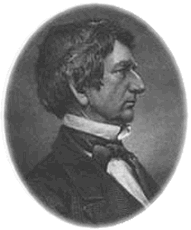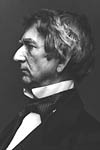|
William H. Seward
William Seward’s political career began in 1830, as state Senator in New York. From 1838 to 1842, he served as Governor, then stepped aside when his opposition to slavery  became a political liability. became a political liability.
In 1848, he was elected to the U.S. Senate, serving until 1861, when he accepted a Cabinet post as Secretary of State under President Lincoln, after losing his own bid for the Republican nomination in 1860.
The debate over the causes of the American Civil War began even before the war itself. In 1858, as U.S. Senator representing New York, Seward took note of the two competing explanations of the sectional tensions that were then inflaming the nation. On the one side, he claimed, stood those who believed the sectional hostility to be “accidental, unnecessary, the work of interested or fanatical agitators.” On the other side, stood those who believed there to be “an irrepressible conflict between opposing and enduring forces.”
As Senator, Seward opposed Henry Clay’s compromise measures of 1850, supported the admission of California as a free state, voiced strong opposition against the Fugitive Slave Act, and argued against the extension of slavery into the territories.
Seward’s first major test as Secretary of State was the Trent affair, late in 1861. The Union Navy had stopped, boarded and removed two Confederate officials from the Trent, an English steamer. The British government demanded the release of the prisoners, reparation, and an apology. Seward, well aware that war with England would be suicidal, spun out the negotiations until Northern opinion had cooled, then returned the pr isoners with an oblique apology. isoners with an oblique apology.
His chief contribution to the Union cause during the War between the States was to deter European entry into the civil conflict on the side of the Confederacy.
After the American Civil War, Seward remained in Europe. Under President Andrew Johnson, he was instrumental in negotiating the Russian treaty for the sale of Alaska to the United States, a venture that became widely known as “Seward’s Folly,” for the common belief that Alaska was nothing but a wasteland.
Seward left public service when Grant became President. He died on October 10, 1872.
|

